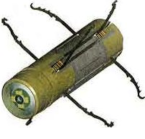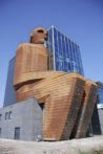Ways of Voyaging Through the Human Body - Workshop, MPIWG and University of Pisa
Organized by Claudio Pogliano (Università di Pisa), Francesco de Ceglia (Università di Bari)
co-financed by the Università di Pisa

- Zoom
- A science fiction film (Fantastic Voyage)
Our attention will focus on the leitmotiv of the Voyage through the human body, which has often been played in the last few decades from different viewpoints, with various aims and outcomes. As for the beginning – although a ‘prehistory’ should be traced in medical writings and in generale literature – 1966 is apparently the crucial year. A science fiction film (Fantastic Voyage) was then directed by Richard Fleischer : a typical Cold War plot based on some special technology that allowed matter to be miniaturized and consequently a microscopic submarine crew to enter inside the body of the scientist who invented the shrinking process. The movie holds the distinction of being the first to deal with the concept of “inner space” : in doing so, it created a new sub-genre. It inspired, among other things, parodies, an animated TV series, a painting by Salvador Dalí, and a double novelization made by Isaac Asimov, up to 1987.

- Zoom
- Dalí, Fantastic Voyage
For instance, Il était une fois…la vie is a French animated television series in 26 episodes telling the story of the human body for children. Since the late 1980s the series was translated in several languages and aired all over the world. During the last twenty years, the rapid innovation in Computer Graphics multiplied the examples of three-dimensional tours of the human body for educational and divulgative purposes, while medical imaging has been developing techniques and processes to visualize what happens deep under the skin. Quite remarkable is the Visible Human Project, an outgrowth of the National Library of Medicine 1986 Long-Range Plan, consisting of the creation of complete, anatomically detailed, three-dimensional representations of the normal male and female human bodies, through transverse CT, MR and cryosection images. Up to 2002 the NLM Project has convened four conferences dealing with the multifarious and changing aspects of the enterprise. Coming to the present, in 2007 the Well Tech Award went to EMILOC (Endoscopic Microcapsule Locomotion and Control) – a disposable and swallowable sutonomous robotic capsule for wireless intraluminal explorations – designed at the CRIM Lab (Scuola Superiore Sant’Anna, Pisa). EMILOC is endowed with a bioinspired locomotion system, controllable by the outside, and represents one of the last episodes of a medical attitude to explore and someway the innermost recesses of human body: an attitude that still waits for some specific historical account.

- Zoom
- EMILOC
By the way, Under Your Skin: A Voyage through the Human Body is the title of a travelling exhibit devoted in 2001 by the Deutsches Museum to illustrate the noninvasive techniques that look inside the living organism and scan its parts with a superior precision. On March 2008, in Oegstgeest (a few miles from Amsterdam) Her Majesty Queen Beatrix opened Corpus – Journey through the human body, a 35 meters high transparent building with the contours of a seated human figure projecting from it. All the detail is inside, of course, where the visitor can see, feel and hear how the human body works. Corpus offers a variety of information and provides education and entertainment.

- Zoom
- CORPUS
These are just a few random specimens of what we plan to investigate. The frequent and growing exploitation of the leitmotiv by literature, art, cinema, television, museums, advertising, has been going along with the various attempts made by technoscience to scan interior body regions and to give a visual rendering of them. It is likely that a circular process, involving various kinds of actors, has been producing a series of scientific and cultural artifacts which might be collected, compared, and studied.
A number of young scholars , willing to approach the topic of the Voyage through the Human Body as a scientific object, entangled in webs of material practices, cultural significance, theoretical and social implications were chosen as "pioneers". The group will collaborate in a small number of workshops , the results will be published.
